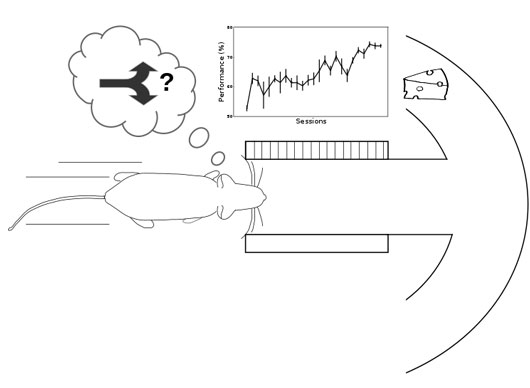The rodent whisker system is a widely used model to study behavioral and neurobiological processes underlying tactile perception, in particular the exploration of an object shape, localization or surface roughness. Similarly to human fingertips scanning an object, rodents are able to sweep their whiskers against surfaces in a rhythmic fashion (a process called whisking) to analyze spatial details. This behavior allows, in particular, to precisely adjust the speed of scanning, and to sample the stimuli several times before making a choice. In addition, while they whisk, rodents are typically standing still. However, in the wild, these animals must be able to make quick decisions while they travel in underground burrows. The tunnels often tightly fit the animals' body size, and the whiskers may therefore contact the walls while the animal is moving inside. We thus hypothesized that rats are able to discriminate between two different surfaces simultaneously, without stopping on them and without whisking.

Figure: Rats had to run in an alley where two stimuli were presented: a smooth surface (white rectangle) and a surface with a regular series of bars (rectangle with lines). At the end of the alley, the animals had to turn to the side on which the regular series of bars was presented in order to receive a reward. Inset plot: learning curve.
To answer this question, we developed a novel discrimination task (Kerekes et al., 2017), where rats run in a corridor and contact simultaneously one surface with regular bars and one with no bars. At the end of the corridor, the animals have to turn either into a right or left arm, according to the side of the rewarded stimulus (the surface with bars). Rats learned the task in eight weeks, and showed performance levels above 70% even though running at high speed (~ 1m/s). Tracking of the whiskers global movement indicated that the animals took a decision as soon as 60ms after the first possible contact, and moreover that they do not whisk on the stimuli. To conclude, rats are able to discriminate between two surfaces within 60ms, while running at high speed, and by contacting the stimuli only once per trial. Moreover, we showed that the neuronal activity in the somatosensory cortex is involved during the discrimination process. This last finding opens new possibilities to explore the cortical coding underlying fast discrimination of tactile features such as pattern regularity or irregularity.
Reference
Bilateral discrimination of tactile patterns without whisking in freely-running rats. Kerekes P, Daret A, Shulz DE, Ego-Stengel V (2017) J Neurosci 37(32):7567–7579.
This week in the journal (Journal of Neuroscience)


































